Of History and Industry: The Legacy of the Ohio & Erie Canal Towpath Trail
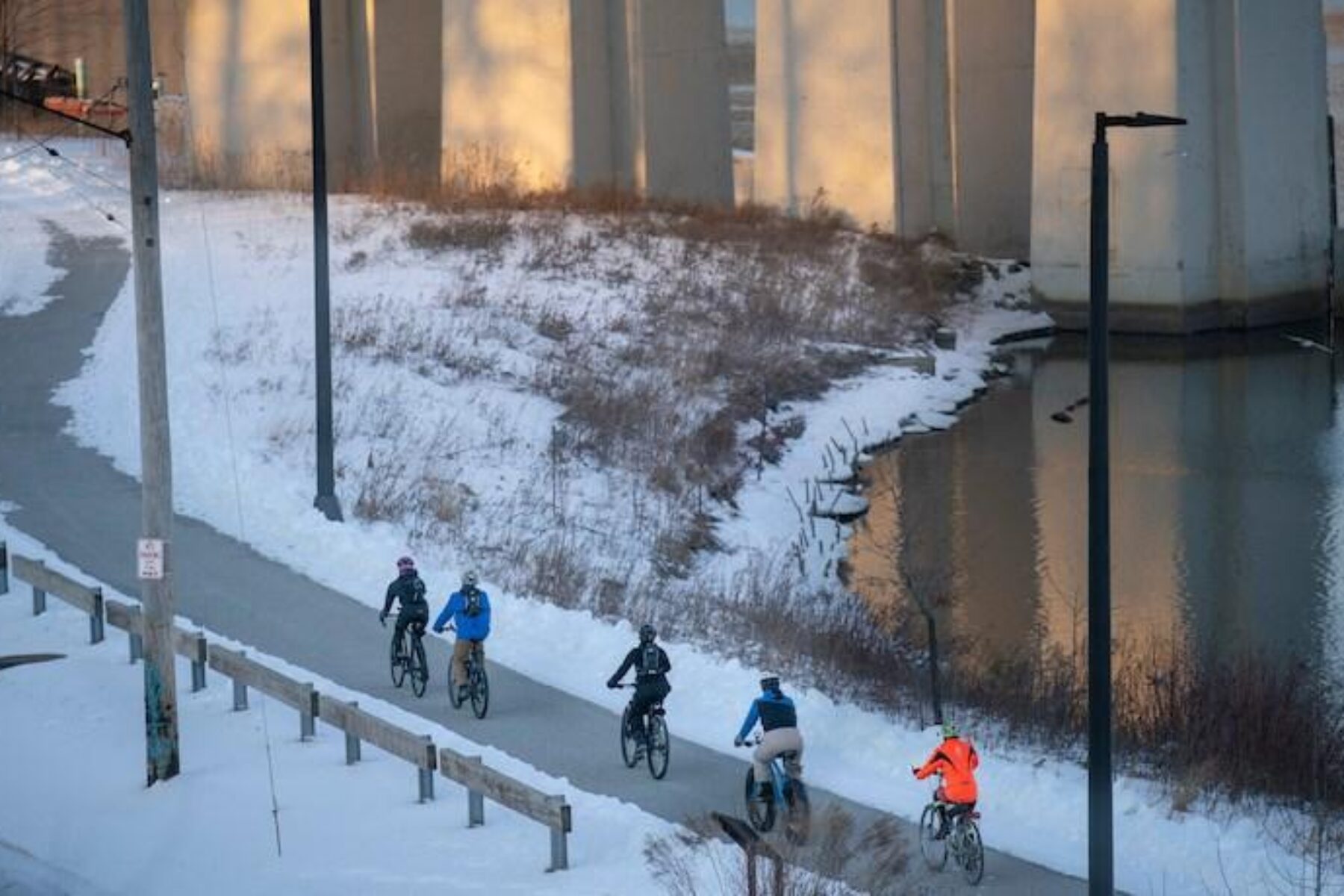
This article was originally published as the cover story in the Winter 2023 of Rails to Trails magazine. It has been reposted here in an edited format. Subscribe to read more articles about remarkable rail-trails and trail networks while also supporting our work.
Diana Hildebrand, better known across Cleveland’s vast bike advocacy community as DevahD, bought her first bike on her 37th birthday, shortly after she and her family moved to the city. It was a hulking 1975 men’s Schwinn steel road bike, and the 8-mile ride she took on the $50 beast the day after she bought it was among the most physically demanding activities she’d experienced. This was said by someone who played defensive back and receiver for three women’s pro football teams.
“It took me three hours to do 8 miles, because I was dehydrated,” she recalled on a frigid mid-November day at Sokolowski’s Overlook in the city’s revitalized Tremont neighborhood, a spot along the Ohio & Erie Canal Towpath Trail (ohioanderiecanalway.com). “I didn’t have everything I needed. My tires were done, and I didn’t even know I had issues with my bicycle. But then I wanted to do more.”
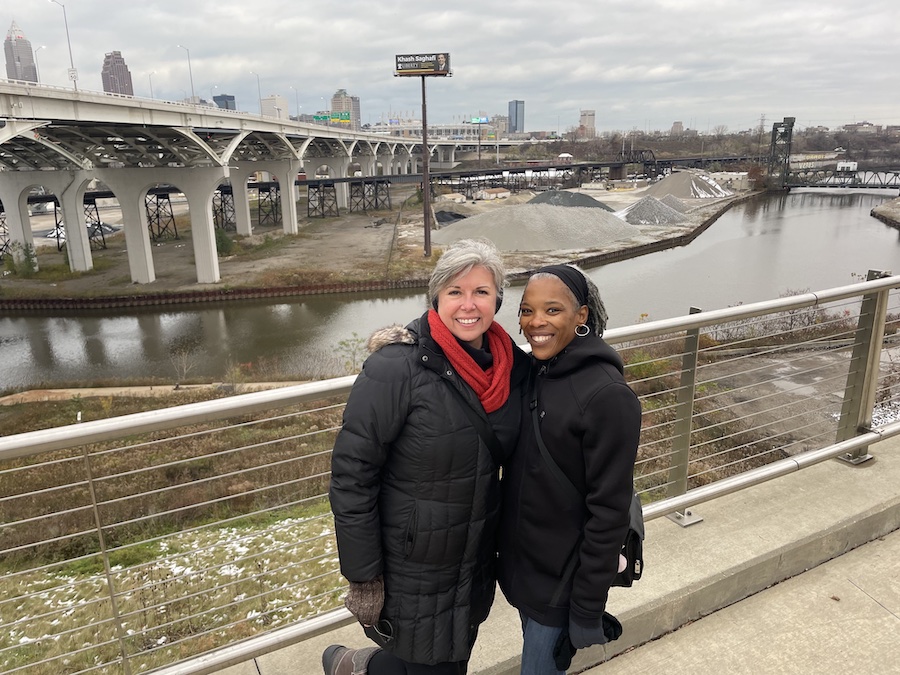
Nowadays, 8 miles, even in Cleveland’s winters, is a piece of cake for DevahD. She improved her splits, upped her miles and educated herself. And then she spread the word, encouraging others in Cleveland to, as she says, change their lives two wheels at a time. And she and other advocates across the city have a newly completed major trail—a spine, as the north-south Towpath Trail is often described—to invite more and more riders into the fold.
For DevahD—who serves as the education and outreach manager for Bike Cleveland, runs her own bike co-op and is a Shero with Cleveland’s chapter of Black Girls Do Bike—the now completed Cleveland portions of the trail have served as an on-ramp for fellow People of Color and underserved populations to explore beyond their neighborhoods.
“This towpath has made it so much easier for people to feel comfortable riding their bikes to a lot of places,” DevahD said. “You can shop off the towpath. You can eat off the towpath. You can play off the towpath. It can’t get any better than this.”
Related: Trail of the Month: Ohio’s Ohio & Erie Canalway Towpath Trail (June 2016)
Collaboration 101
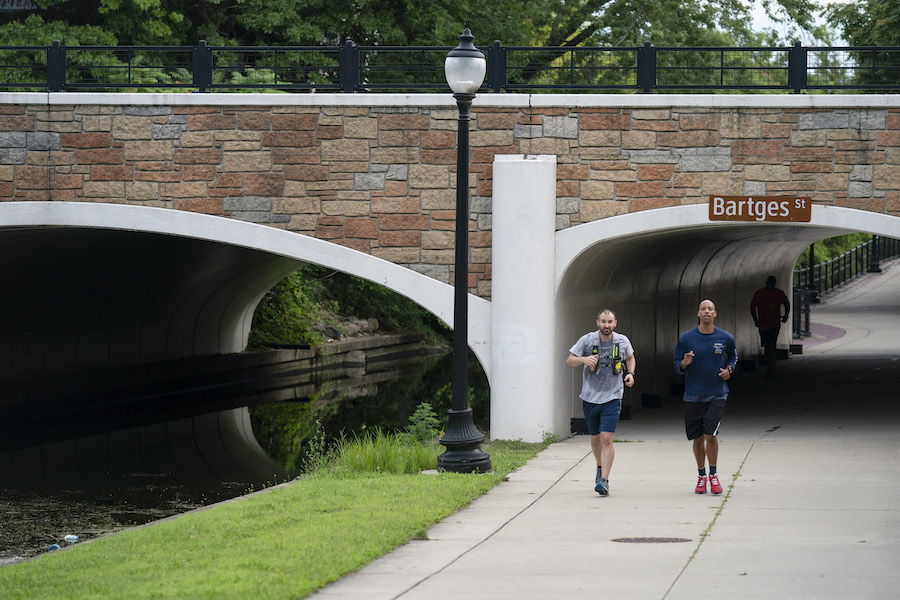
From Sokolowski’s Overlook, you see the downtown skyline, the curling Cuyahoga River, industrial zones and burgeoning wildlife habitats all at once. You also often see cyclists and runners on the paved trail winding south from the Scranton Flats neighborhood up a challenging hill, also nicknamed for the Sokolowski family that for generations operated the famed University Inn restaurant across from the overlook.
It’s about 1.3 miles from the overlook by trail—or less than half the distance a drive would take—to get up to Canal Basin Park, the northern terminus of the towpath, located in the shadow of Downtown Cleveland, near the confluence of the Cuyahoga River and Lake Erie.
Currently 90 miles and counting, the trail, when complete, will run for 101 miles—from the park south through Cuyahoga, Summit, Stark and Tuscarawas counties. It connects Cleveland (whose miles of the towpath are finished after decades of work), Cuyahoga Valley National Park and Akron, as well as many Northeast Ohio communities, along a path that largely traces one first cut by the 1832 Ohio & Erie Canal.
In Cleveland, and along the entirety of the towpath, trail developers laud collaboration as key to pushing the $56 million project forward past numerous roadblocks.
“We came about a dozen years ago to what we call the four-party agreement,” said Mera Cardenas, who serves as executive director of Canalway Partners. “That was Canalway as the nonprofit, the City of Cleveland, Cuyahoga County and Cleveland Metroparks. This would not have happened if every single one of those four parties hadn’t come together and invested time and effort and [looked] for financing.”
Cardenas succeeded longtime Canalway director Tim Donovan and serves alongside Akron-based Dan Rice as a co-executive director of the Ohio & Erie Canalway National Heritage Area.
“Each new section of the trail that is developed is a major accomplishment, because it requires a lot of perseverance, dedication and hard work by many, many partners,” said Rice, who is also president and CEO of the Ohio & Erie Canalway Coalition. “And the most recent connection up in the Cleveland area is a major milestone.”
River of Change (Embracing Its Industrial Roots)
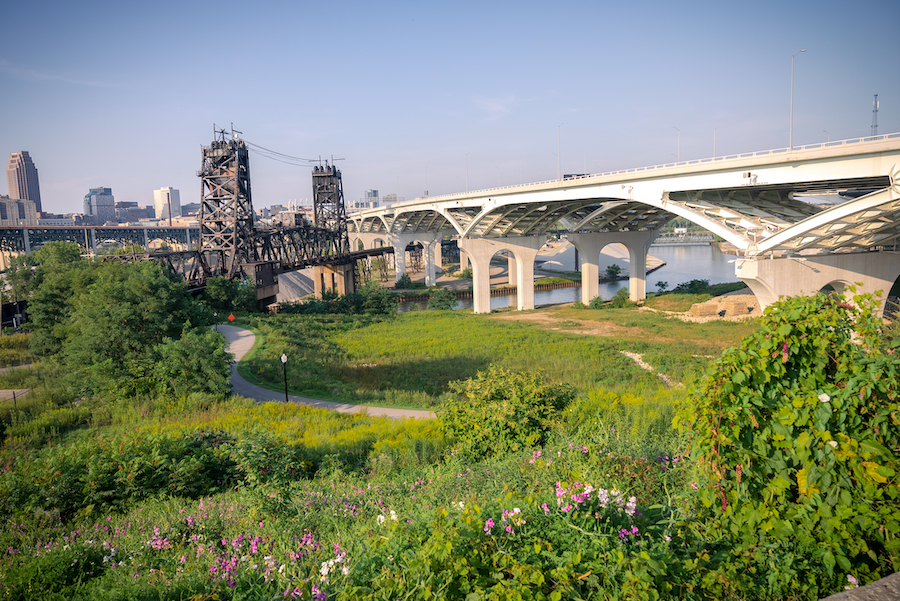
The Ohio & Erie Canalway was designated a National Heritage Area in the mid 1990s, and that kickstarted the process of converting what was once an industrial passageway into the multiuse trail the towpath has become. (For a comprehensive recap of the Towpath Trail’s development, read longtime Cleveland journalist Steven Litt’s dispatch from the June 2021 ribbon cutting of the northernmost trail segment.)
The City of Cleveland has long targeted Canal Basin Park as a destination for nearby downtown residents and a place to spotlight the history of industry in the surrounding Flats. “This is where the boats would have pulled in, been weighed—pulled into almost like a parking lot, which is the basin, while they waited for their turn to head south,” Cardenas said. “Or if they came north, they would have waited for their turn to exit the canal. Once the canal stopped operating out of there, you know, it’s just industry on top of industry on top of industry. But we’re turning it into a 20-acre park.”
Within a few minutes of meeting Cardenas at the park, which two years ago was basically a parking lot, we spotted a groundhog. Wildlife has returned all around the once-deadened Cuyahoga.
The river, infamous for catching fire in Cleveland in the summer of 1969, earned an Ohio Water Trail designation in 2019 after decades of efforts to address unregulated industrial pollution that wrecked the river and caused the famous fire (and at least a dozen others before the one fire made international news). The burning river, and the local reaction to it, spurred environmental action, influencing the creation of the Environmental Protection Agency and the Clean Water Act, the 50th anniversary of which was recently celebrated on the banks of the Cuyahoga.
Canal Basin Park represents the only portion of the Towpath Trail in Cleveland’s Cuyahoga County that overlaps with the path of the transcontinental shipping route that first paired heavy industry with the river.
The city’s industrial roots are embraced along the towpath. At Steelyard Commons, a shopping center built where a Tremont steel factory once stood, a massive railcar designed to transport molten iron is on display. Down from Sokolowski’s Overlook, six swings along the trail point at an asphalt facility located on the banks of the Cuyahoga below. Near the swings are a replica Civil War cannon and benches designed to represent barrack beds that were used in this space when it was home to Camp Cleveland. A little over a mile down the trail from the swings are the Towpath Mounds, a natural feature designed to mimic industrial material rock piles. At the same time, major investments have been made to restore brownfields with native plants and, as Cardenas said, soften the edge of the changing Cuyahoga.
When Cardenas and I passed by the swings, a murmuration of gulls drifted above the river.
“I’ve never seen them do that without a freighter coming in,” she said.
Akron Program Offers Equitable Trail Access
In Akron, Ohio, as trail and waterway projects have branched off the Ohio & Erie Canal Towpath Trail, and bikeability has become an ever-greater focus of urban planning, the Ohio & Erie Canalway Coalition has developed a program to make sure everyone has access. In non-winter months, you can borrow a red bike or watercraft through the Summit Bike Share program.
“Providing equity in public spaces is one of our foundational values, because not everybody can afford to rent a bicycle,” said coalition President and CEO Dan Rice. “Not everybody can afford to rent a canoe. But yet, everybody should be able to have access.”
Currently there are “share stations” set up at 10 public and private locations throughout Akron. To get a bike, users have to show ID or a credit card, and that’s it. They have a ride for two hours. Rice said several thousand riders have already taken advantage of the program.
Tourists—and Wildlife—Flock to Towpath
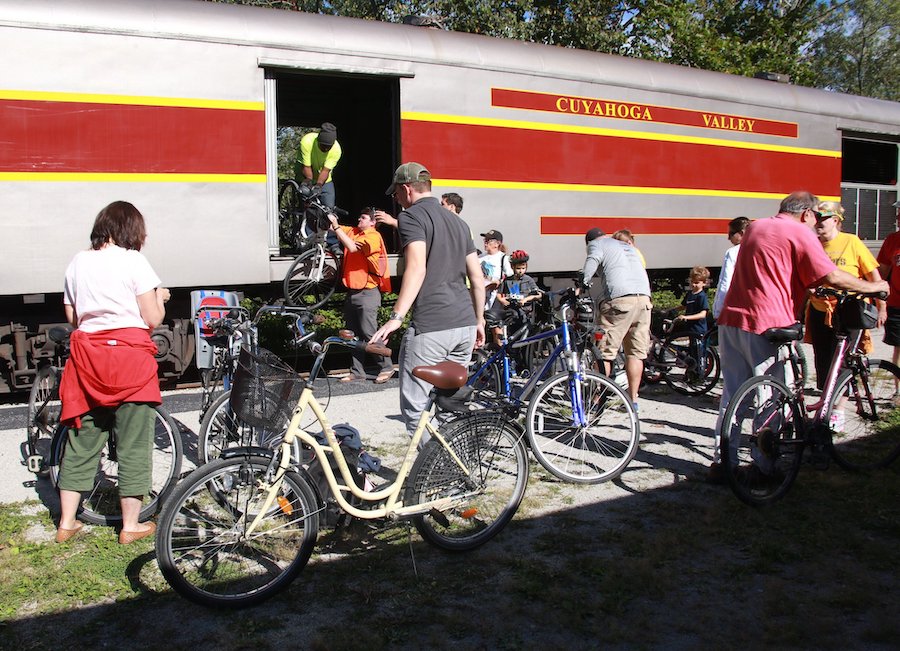
About 23 miles south of Cleveland in Peninsula, population 530, there are two bike shops—Pedego Electric Bikes and Century Cycles—located within a block of each other on Main Street, steps away from the Lock 29 Trailhead of the towpath. (There are still remnants of the original canal locks beside the trail, often paired with historical markers.)
They are also right by the Peninsula depot of the Cuyahoga Valley Scenic Railroad (or CVSR), which has been offering bike cargo service for towpath users ever since the first miles of the trail opened in Cuyahoga Valley National Park in the early 1990s.
“People can ride anywhere onto the towpath, stop [at a station and], for $5, throw their bike and themselves onto the train and come right back to where they started,” said Ron Bercaw, a longtime sales associate at Century Cycles. “We have a lot of people that’ll rent bikes here and go to the train station just—right up here—and jump on and go to one end of the park or the other and ride back.”
The service is called the Explorer Bike Aboard Program, and it extends to waterway users as well. The national park is home to over 20 miles of the 100-mile Cuyahoga River Water Trail, which offers scenic paddling along the unique U-shaped river that empties into Lake Erie.
“The train provides a beautiful ride into our national park and the opportunity to have more time in the park hiking, biking or kayaking by reducing travel time,” said Joe Mazur, president and CEO of CVSR. “The journey is up to the rider, but our excursions are designed to pro vide a scenic experience that enhances the park visit.”
For cyclists, Bercaw said he usually recommends newcomers start to the south.
“In about 3 miles, you’ll come to this big farm store called Szalay’s, and they’re kind of famous for their sweet corn,” he said. “They cook food out during the summer; they have live entertainment. And then about a half-mile past that is the Beaver Marsh, where there’s a big beaver dam. The river otters are repopulating down there. [You’ll] see some blue herons, some ospreys maybe if you’re lucky.”
The Ohio Department of Natural Resources credits dam removals and cleaner water for bringing over 50 types of fish back into the river’s population. And as the river has reawakened, so too has life along its banks. In the later 2000s, bald eagles were spotted nesting in Cuyahoga Valley National Park, which spokeswoman Pamela Barnes said drew major buzz.
“To think of bald eagles coming back to a river that kind of was declared dead,” she said. “It was a victory.”
The mid-November morning I visited Peninsula, Bercaw and Kevin Madzia, the shop’s IT manager, spotted two bald eagles outside the shop window. I missed those, but saw scads of waterfowl and a few blue herons on a brisk midday towpath hike near the park’s Boston Mill Visitor Center, one of Barnes’ many recommended destinations in the park.
Barnes said the Towpath Trail drew wildlife watchers even before the first miles of the trail system were developed in the national park in the early ’90s.
“One of the first interpretive programs I did was a little hike, and we did a little bit of bushwhacking through what is now the Beaver Marsh—before there was a boardwalk there, before the trail was actually cleared,” Barnes said. “So there were local people who were using the sections of what was the Towpath Trail for recreation and for wildlife watching. It’s pretty cool to see it come to fruition all these years later.”
A 2015 study estimated the annual economic impact of the Ohio & Erie Canalway National Heritage Area at about $408 million. It also supports 4,200 jobs and generates nearly $35 million in tax revenue each year, according to the study. The report spotlighted the Towpath Trail for drawing about 2.5 million visitors annually to the National Heritage Area. The report was released shortly after a $9 million park and trail component of the towpath opened in 2014 along the river in Cleveland’s Scranton Flats neighborhood, but before all of Cleveland’s towpath miles were completed.
“Now that the trail is more connected all the way into Cleveland, it gives people around here more opportunities to go places,” Madzia said. “And it’s also bringing people from all over the country, because they’re using that Cincinnati to Cleveland route. I’ve talked to people that have come from all over the country just to do that.”
He continued, “I did the same thing with that route from Washington, D.C., to Pittsburgh [via the Great Allegheny Passage (gaptrail.org) and C&O Canal Towpath (canaltrust.org)] a few years ago, and I ran into a mother and daughter there from Idaho. They flew to Pittsburgh just to ride that trail. And we’re starting to see that here, but I think we won’t see it really take off until it’s 100% connected.”
In Tuscarawas County, where the trail connection ends near the historic Zoarville Station Bridge, Jesse Rothacher, the county park manager, said progress is being made. The county is in a design and engineering phase to develop an additional 2 miles of trail from the bridge to the dam in Dover, which gets the towpath closer to the county’s two largest areas, Dover and New Philadelphia.
There is more work to be done, said Rothacher, whose department didn’t exist until local supporters of its mission helped see it launched in 2004.
“What we’ve accomplished here in Tuscarawas County has taken longer than maybe some people would like, but it’s really remarkable what we’ve been able to get done, because it’s an incredible public-private partnership,” he said. “A lot of the development that we have wouldn’t be possible without hundreds of volunteer hours, without local foundations, without local businesses, without other supporting nonprofits within the community.”
The Towpath Trail: A State, Regional and National Connector
Eventually spanning 101 miles, the Ohio & Erie Canal Towpath Trail is a major trail destination and economic generator in the Buckeye State and Midwest, bringing in an estimated 2.5 million visitors annually, according to a 2015 study of the Ohio & Erie Canalway National Heritage Area.
The Towpath Trail also makes up a 67-mile portion of the 326-mile Ohio to Erie Trail and is a host trail for two massive developing trail networks: the 1,500-mile Industrial Heartland Trails Coalition network, an RTC TrailNation™ project, and the 3,700-mile cross-country Great American Rail-Trail®, which is more than 54% complete to date and will eventually connect Washington, D.C., and Washington State.
Opening Up New Connections
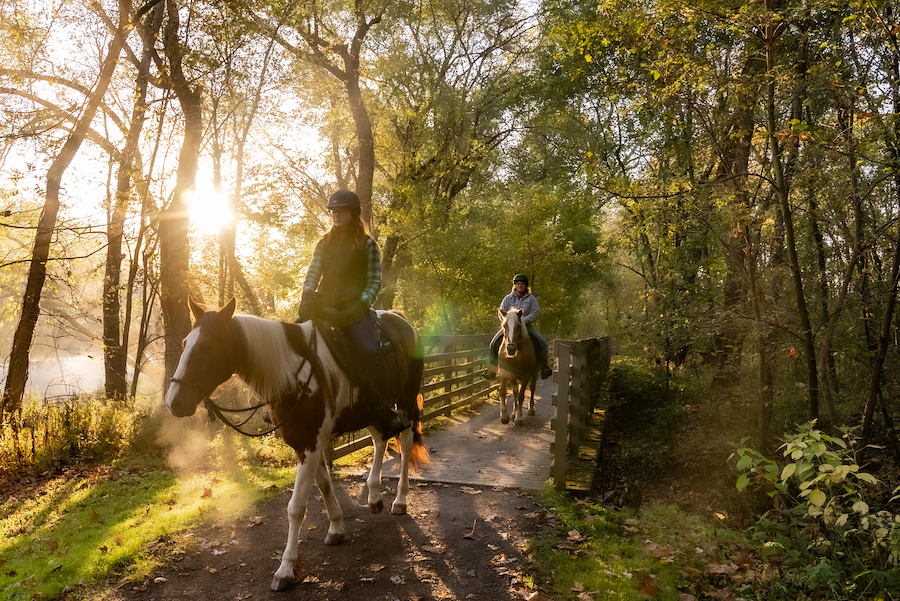
A 2021 survey of 5,230 Cleveland Metroparks users found walking and hiking on paved and unpaved trails are the biggest draws to the department’s parks. Sara Byrnes Maier, senior strategic park planner for Cleveland Metroparks, said the Towpath Trail and other major trails can provide many users their first look at other Metroparks offerings that have been developed along the network.
We met at one of the newest ones, Cliffs Bike Park. The park features a set of ramps and jumps for BMX bikers and skaters and shares a parking lot with CanalWay Center in the Cuyahoga Heights neighborhood. The towpath runs right past both.
“We want to reach a diverse group of users and have something for everyone, and since this was such a large area that was kind of underutilized and is centrally located—it made sense to do something like this here,” she said. “And the towpath going past … you know, hopefully people will stop off, take a look at it and come back.”
Metroparks handles the day-to-day maintenance of the towpath, which is on city land. The project was managed by Cuyahoga County, and Canalway Partners handled chief fundraising, community outreach and other elements. Cooperating on a project that threw every challenge possible at them—Maier said she was sure the person who told her a Manhattan Project site stood in the way of one earlier towpath design was joking, but it did—has proven the partners can work together and with other agencies to build up around the Towpath Trail.
“We’ve got the scaffolding to be able to do things and scale them,” Maier said. “We’ve learned that.”
She pointed to the recent completion of five projects funded in part with millions in federal Transportation Investment Generating Economic Recovery (TIGER) grant money (now known as Rebuilding American Infrastructure with Sustainability and Equity, or RAISE): the Wendy Park Bridge, Whiskey Island Connector, Red Line Greenway, Cleveland Lakefront Bikeway Connector and Canal Basin Park Connector. Those projects opened up numerous connections along the west side of the Cuyahoga.
The next big project on the horizon, she said, is the Slavic Village Downtown Connector, which will add nearly 6 miles of trails and connectors on the city’s underserved East Side. Metroparks recently received a $950,000 RAISE grant to plan and design the segments, and Maier said her successful grant application referenced the partnerships that got the towpath to the finish line.
Related: Bridge to Everywhere: Examining Signature Gateways Across America
A Pathway for Agency, Equity and Opportunity
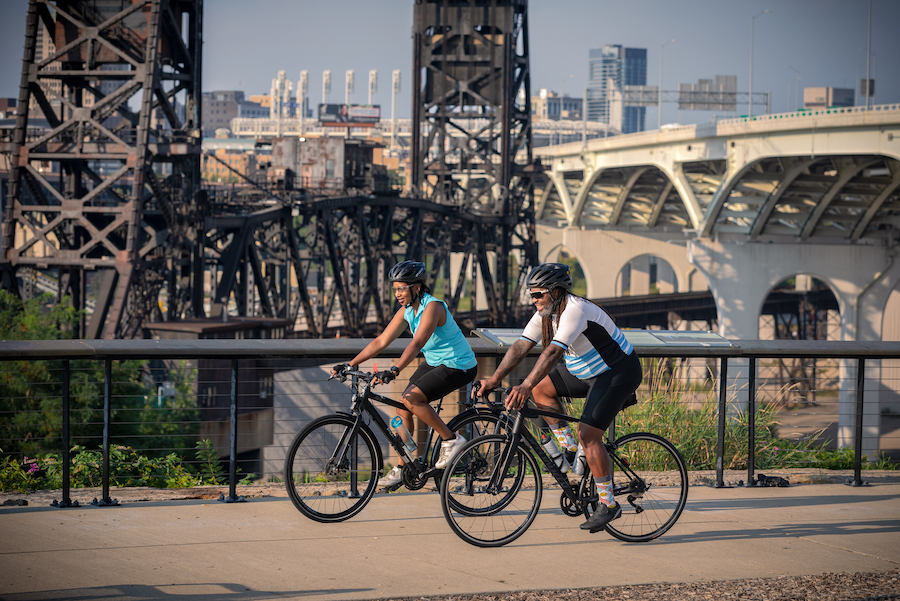
Once Cleveland’s Towpath portion was online, DevahD was ready to go. Two years ago, Hildebrand led a group of women from Cincinnati on the Ohio to Erie Trail—a 326-mile route that included about 67 miles of the towpath—all the way home to Cleveland.
“The value that they received is that they feel like they can do anything at this point,” Hildebrand said. “The ladies that I did the ride with—now they’re actually out here riding on different trail systems. They’re traveling, and they want to explore a whole lot more.”
For herself, the trek affirmed her role as a community leader, as well as her love of biking.
“I love our trail system,” she said. “I like the fact that when we were riding, I could tell them about what we were seeing. We can look up in the sky, and I can identify wild birds for them. And then just talking about the spiritual connection that we actually had. And then on top of that, the sisterhood that we created toward each other.”
Related: Top 10 Trails in Ohio

When you subscribe to Rails to Trails magazine, you’ll have access to many other features like this one. Our magazine is a premium of Rails-to-Trails Membership. Join today to start receiving the magazine!

Donate
Everyone deserves access to safe ways to walk, bike, and be active outdoors.



